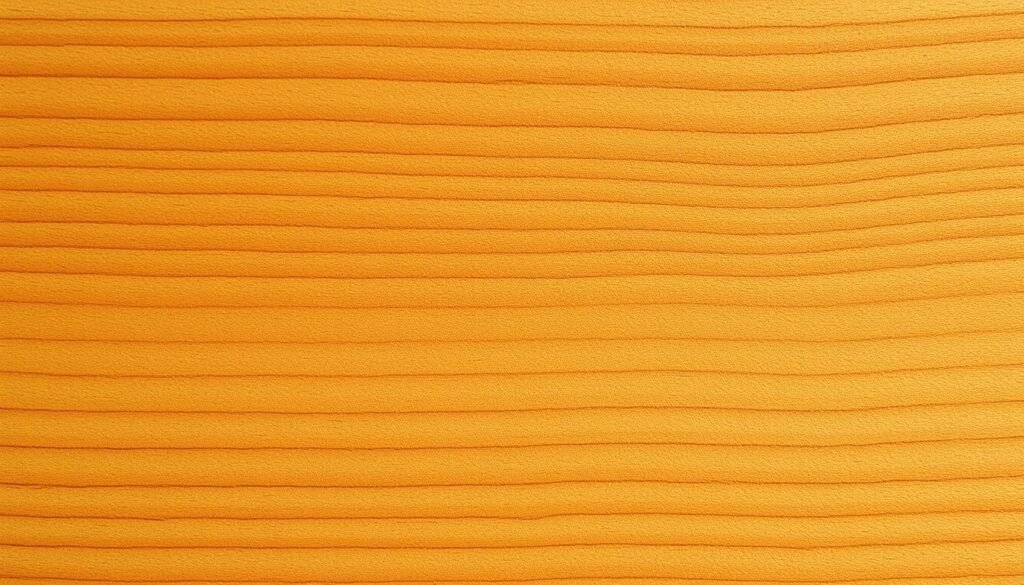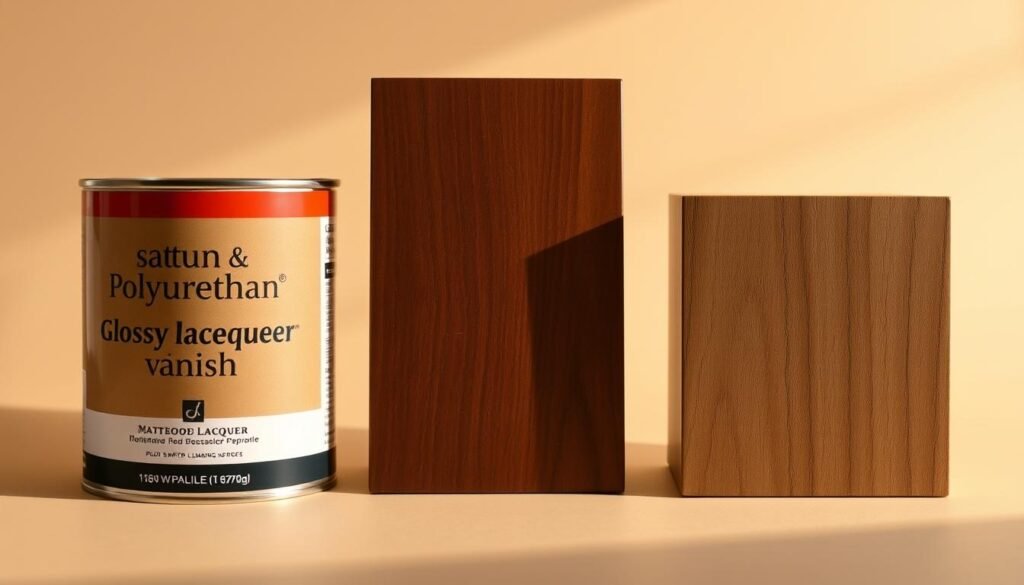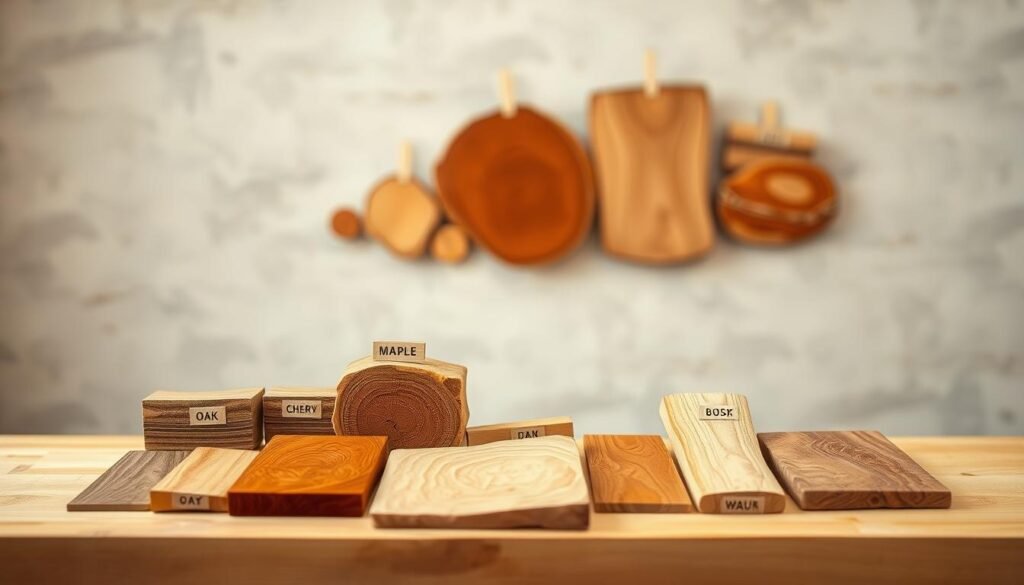Modern homes mix old craftsmanship with new looks. Timeless woodworking joinery styles play a big role in this mix.
These classic methods make furniture and buildings strong. They also make a space look good. By using
Contemporary woodworking combines old skills with new tastes. It makes any room look better by blending tradition with modern.
The Renaissance of Traditional Woodworking in Modern Design
Traditional woodworking is back in modern furniture, focusing on sustainability. People want eco-friendly furniture now. Traditional methods use local, sustainable materials and cut down on waste.
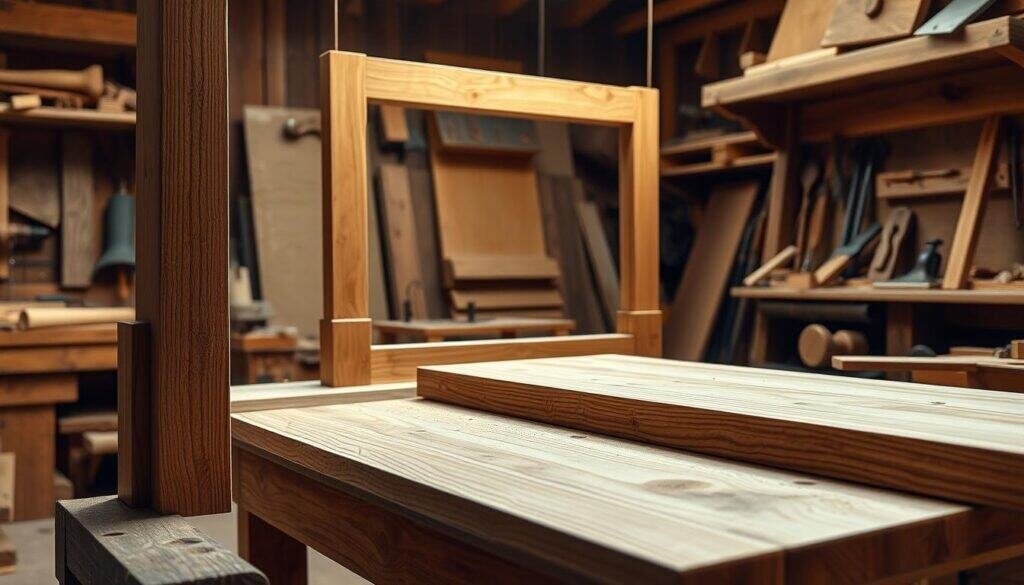
Using traditional woodworking in modern furniture means things last longer. These pieces look great and are built to endure. This means we don’t need to replace them as often, which is better for the planet.
Sustainability and Longevity in Modern Furniture
Traditional woodworking meets modern design in sustainable, durable furniture. Quality craftsmanship and eco-friendly materials make these pieces last. They stand the test of time.
This approach is good for the environment and improves furniture quality. More people want furniture that’s both traditional and modern. This is making traditional woodworking popular again in the industry.
Modern designers using traditional woodworking create unique, green furniture. This mix of old and new is changing the furniture world. It’s moving towards a more sustainable and lasting future.
Woodworking Joinery Styles That Match Today’s Interior Trends
Woodworking joinery styles are changing to fit today’s interior trends. They mix function with beauty. The joinery choice greatly affects a room’s look and feel.
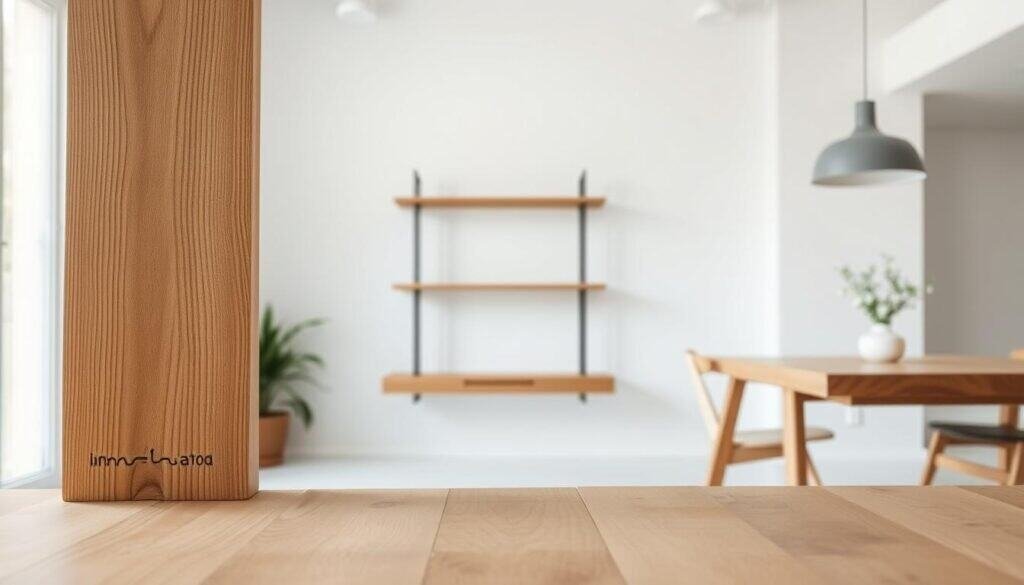
Modern joinery is more than just holding wood together. It’s an art that adds character and elegance to any space. Whether it’s visible or subtle, the joinery style greatly impacts a room’s look.
Balancing Visibility and Subtlety in Modern Joinery
Finding the right balance between visible and subtle joinery is key in modern interiors. Visible joinery highlights craftsmanship and uniqueness. Subtle joinery, on the other hand, offers a clean, minimalist look.
Designers and homeowners can pick from many joinery styles to fit their trends. For example, dovetail and mortise and tenon joints are both functional and decorative. They can make furniture and shelves more visually appealing.
The choice of joinery style depends on the desired look and the level of craftsmanship. Knowing about different joinery styles helps make informed choices. This way, you can create interiors that are both stylish and practical.
Dovetail Joints: Timeless Elegance for Modern Furniture
Dovetail joints are a perfect mix of old-school craftsmanship and new design. They’ve been a sign of top-notch furniture making for ages. Their use in today’s furniture shows the lasting charm of traditional methods.
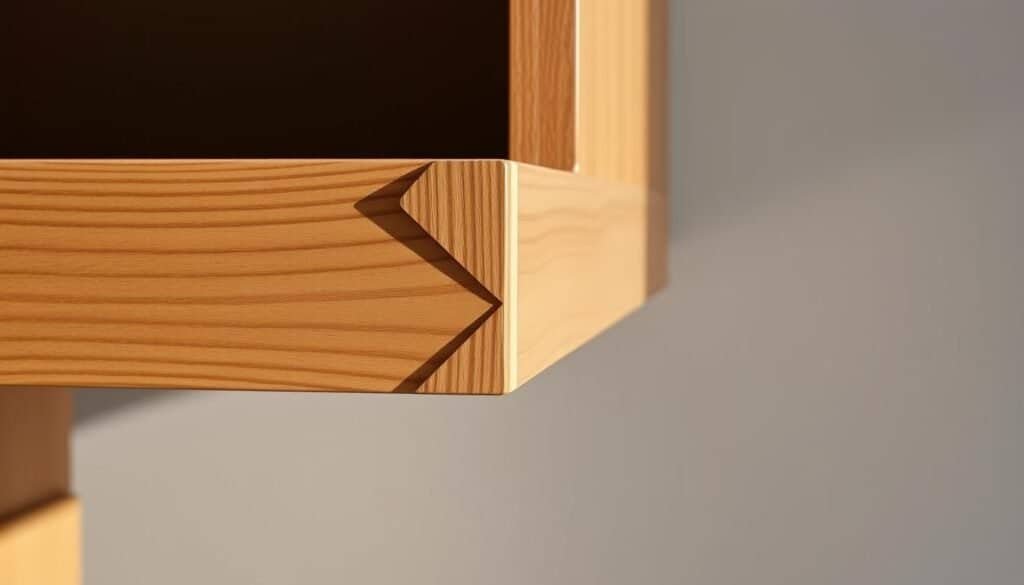
Through dovetails are special because they’re strong and look good. They’re seen on the outside of drawers and boxes. This makes them a key part of modern furniture’s beauty and skill.
Through Dovetails as Design Features
The tails and pins of through dovetails make a stunning pattern. This pattern can be the main attraction of a piece. It shows off the maker’s talent, turning a useful joint into a piece of art.
Half-Blind Dovetails for Drawer Construction
Half-blind dovetails are used for drawers where you can’t see them from the outside. They keep the drawer strong and simple, fitting well with modern furniture’s clean look.
Dovetail joints, whether through or half-blind, show a dedication to quality and skill. As people look for furniture that’s both strong and looks good, dovetail joints are becoming more popular. They bring together old and new in a beautiful way.
Mortise and Tenon: Ancient Technique with Modern Applications
The mortise and tenon joint is an old woodworking trick that’s back in style. It’s a method where a piece (tenon) fits into a hole (mortise). This technique has been around for ages and is loved for its strength and beauty.
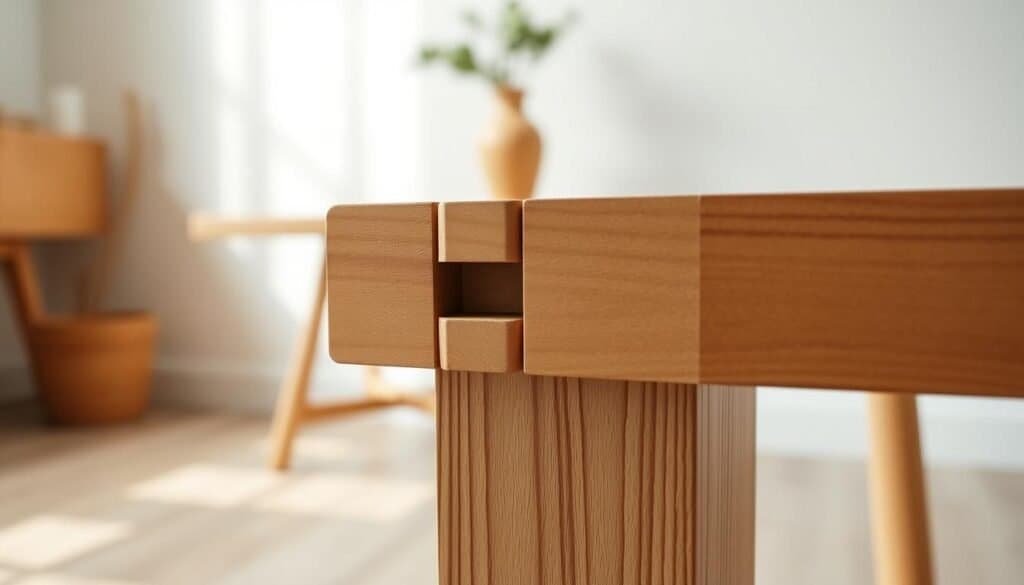
Today, the mortise and tenon joint is prized for its strength and design flexibility. It’s used to make furniture both useful and pretty.
Through Tenons as Decorative Elements
Woodworkers are now using through tenons to add beauty to modern pieces. By making the tenon visible, they bring a traditional touch to new designs. This not only highlights the wood’s grain but also adds a genuine feel to the furniture.
Hidden Mortise and Tenon for Clean Lines
On the other hand, mortise and tenon joints can help create simple, modern looks. By hiding the joint, designers can make wood pieces seem to blend together smoothly. This style is a hit in modern and minimalist designs.
The mortise and tenon joint’s flexibility makes it a key part of woodworking today. It’s used to add flair or keep designs simple. This ancient method is as important in today’s furniture making as it was in the past.
Japanese Joinery: Bringing Zen Aesthetics to Western Interiors
Adding Japanese joinery to Western interiors brings calm and style to modern spaces. This method is known for its simplicity and beauty, adding a Zen feel to furniture. It focuses on making strong, lasting joints without nails or screws, highlighting the wood’s beauty.

Using Japanese joinery in modern design makes furniture look better and supports sustainable woodworking. Craftsmen create pieces that are both useful and eye-catching. They focus on the wood’s quality, making each piece special.
Tools and Techniques for Japanese-Inspired Joints
To make Japanese-inspired joints, woodworkers need certain tools and know-how. They need top-notch chisels, hand saws, and marking gauges. The tools must be sharp and used with care for precise joinery.
Techniques like mortise and tenon, dovetail, and halving joints are key in Japanese joinery. Learning these skills lets craftsmen make stunning, complex pieces that show the beauty of Japanese woodworking.
Finger Joints: Geometric Precision for Scandinavian-Inspired Spaces
Finger joints add precision and elegance to Scandinavian-inspired spaces. They create a strong bond, perfect for drawers, cabinets, and more. This makes them a favorite for building furniture.
The clean lines and minimal look of Scandinavian design shine with finger joints. They not only strengthen the piece but also highlight the skill of the craftsman.
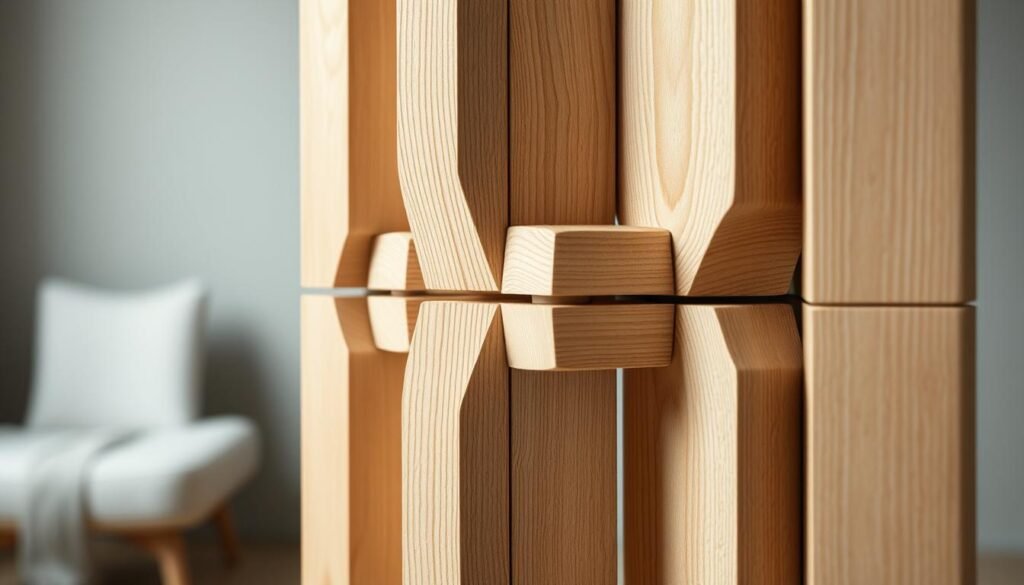
To make perfect finger joints, you need the right tools. A table saw or router table with a finger joint jig is essential. These tools help cut the fingers accurately, ensuring a tight fit.
Beginners should practice with scrap wood to get the hang of it. Adjusting the jig and using the right clamping techniques are key. This ensures the joint dries without gaps or misalignments.
In Scandinavian furniture, the finger joints are often on display. Their clean look and the visible craftsmanship enhance the design. This blend of function and beauty is a hallmark of Scandinavian style.
Bridle Joints: Structural Integrity with Visual Appeal
Bridle joints are special in woodworking. They mix strength with beauty. For centuries, they’ve been key in making furniture, connecting wood pieces in a strong and attractive way.
These joints are known for their strength. They lock two pieces of wood together, making a bond that can handle a lot of stress. This is why they’re great for furniture that holds a lot, like tables and shelves.
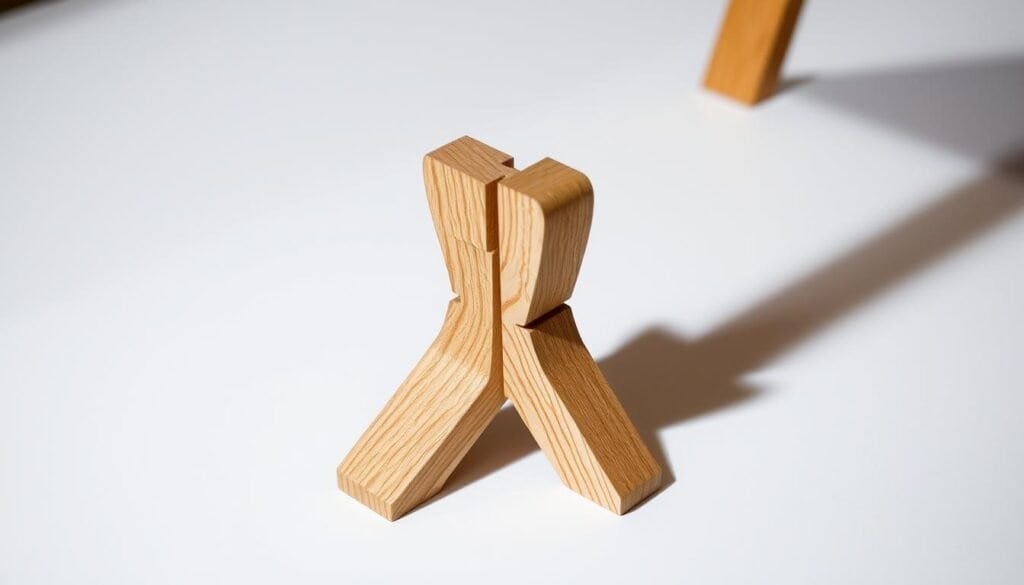
Bridle joints also look great. The exposed wood grain adds texture and interest. This makes them a favorite among furniture makers who want to show off their skill.
Modern Adaptations of Traditional Bridle Joints
Even though bridle joints are old, they’re used in new furniture too. Modern makers use them to add a personal touch to their work. They mix old joinery with new materials and designs, creating unique pieces.
Bridle joints fit many design styles. They work in rustic and modern furniture alike. Whether it’s a wooden coffee table or a simple shelf, they add a touch of elegance.
Miter Joints: Creating Seamless Transitions in Contemporary Pieces
Miter joints are key for woodworkers aiming at modern designs. They make wood pieces blend smoothly, a must in today’s furniture. By cutting wood at a 45-degree angle, woodworkers create joints that look great and feel solid.
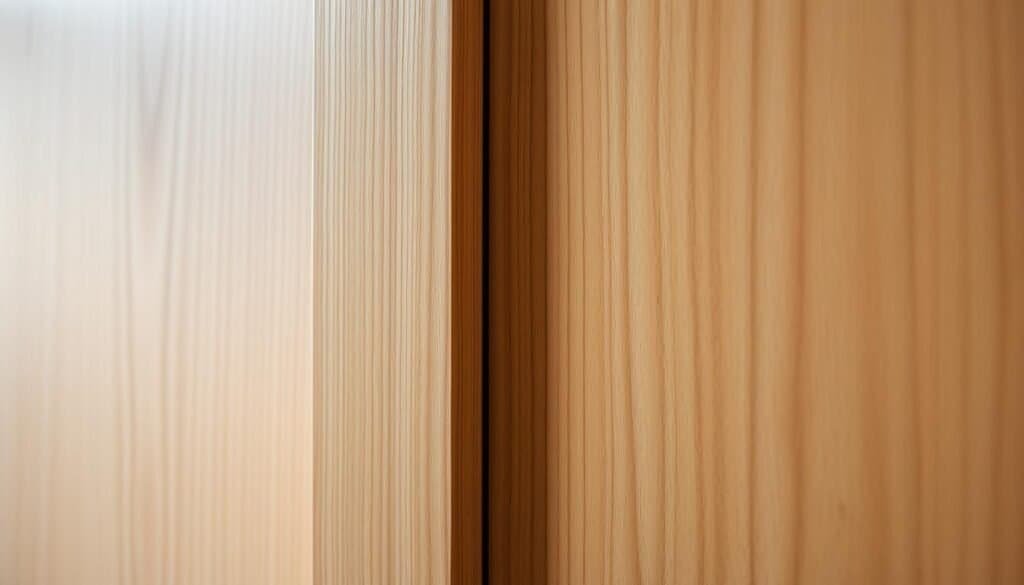
Getting miter joints right needs the right tools and skills. Woodworkers use miter saws, table saws, and hand saws for precise cuts. The tool choice depends on the project and the woodworker’s style.
Achieving Perfect Miters: Tools and Techniques
For perfect miters, woodworkers need to measure accurately and cut precisely. Miter saws and table saws with miter gauges help a lot. Testing cuts on scrap wood before the real piece is a good trick.
Clamps and adhesives are key for a strong miter joint. Even pressure from clamps and the right adhesive keep the joint tight. This care makes furniture stand out in today’s world.
Miter joints are not just useful; they also make furniture look better. A well-made miter joint can enhance the clean look of modern designs. It’s a skill every woodworker should learn.
Lap Joints: Simplicity Meets Functionality in Modern Design
Lap joints are perfect for modern furniture because they are simple and functional. They involve overlapping two pieces of wood to make a strong and clean joint.
The beauty of lap joints is their easy construction. They don’t need complex cuts or shapes. This makes them a key part of modern furniture designs.
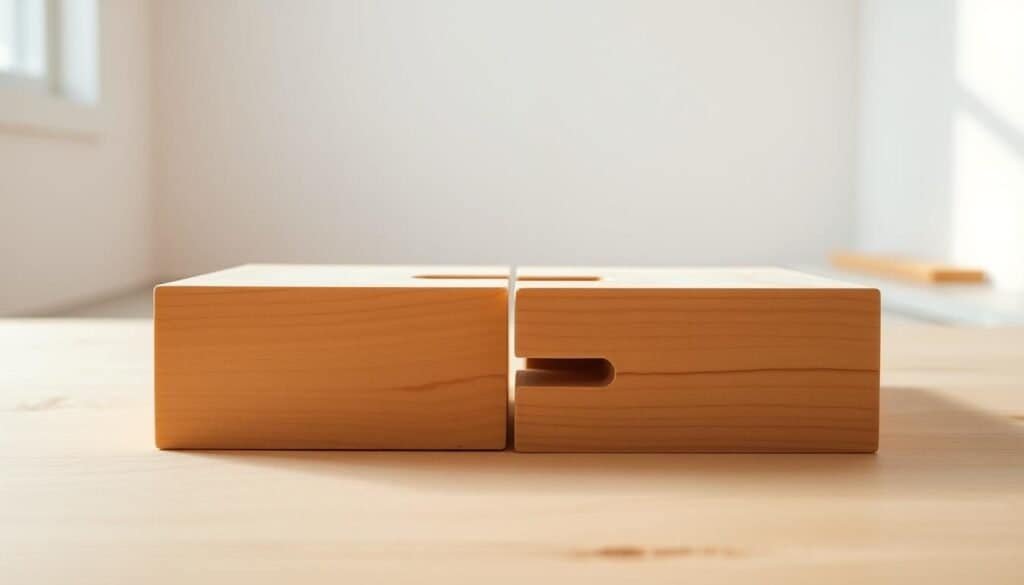
In modern design, lap joints are often shown off as a design choice. This adds character to furniture. It shows the skill and care in making each piece.
These joints are not just pretty; they also make the furniture strong. They show how form and function can work together beautifully.
Using lap joints in modern furniture shows a love for traditional skills and the beauty of wood. So, lap joints keep shaping the look of today’s homes.
Dowel Joinery: Invisible Strength for Clean Aesthetic Lines
Dowel joinery is a skill that makes strong joints without visible fasteners. It’s a top pick for modern furniture makers who want clean lines.
This method uses dowel rods to strengthen joints. It’s great for making cabinets, tables, and other furniture where you don’t want to see the joints.
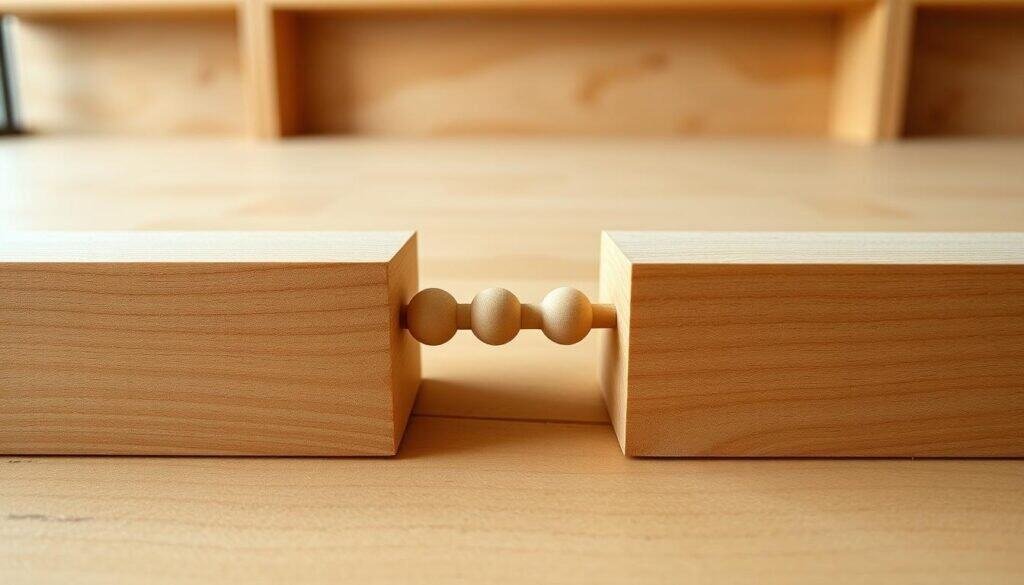
Self-centering doweling jigs are key for precise dowel joinery. They make sure dowel holes are drilled right, leading to perfect joints.
Self-Centering Doweling Jigs for Precision Work
Self-centering doweling jigs make drilling dowel holes easier. They keep the drill bit centered, avoiding mistakes. This means joints are strong and well-aligned.
Using dowel joinery and these jigs helps woodworkers get precise and clean work. It’s perfect for making modern furniture with hidden strength and clean looks.
Spline Joints: Adding Decorative Accents to Contemporary Furniture
Spline joints are more than just a way to join wood. They also add beauty to furniture. In today’s furniture making, spline joints can make a piece go from useful to stunning. They let craftsmen create joints that catch the eye and become a key part of the design.
The beauty of spline joints comes from the splines themselves. Unlike hidden joinery, spline joints can be made to stand out. This is done by using different woods or materials for the spline. This contrast adds elegance and sophistication.
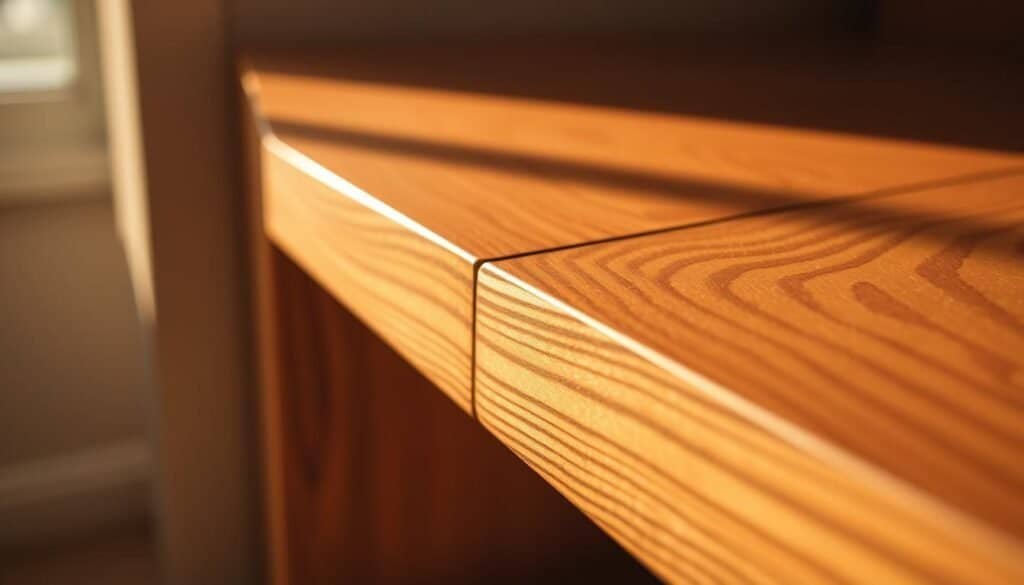
For truly unique pieces, craftsmen can design custom splines. These splines are not just for joining; they’re also decorative. They can use various materials like ebony, rosewood, or metal to create a special look. The goal is to mix the decorative with the furniture’s overall look.
Custom splines can match any furniture style, from modern to traditional. By focusing on the spline joint’s details, craftsmen can make each piece special. This personal touch makes each item unique.
In summary, spline joints are a great way to add beauty to modern furniture. They make each piece not just useful but also a masterpiece. By trying out custom splines, designers can show off their skill and care in every piece.
Tongue and Groove: From Traditional Flooring to Modern Wall Features
Tongue and groove joints have evolved from classic flooring to modern wall designs. They were once used to make flooring smooth and flat. This provided both strength and beauty.
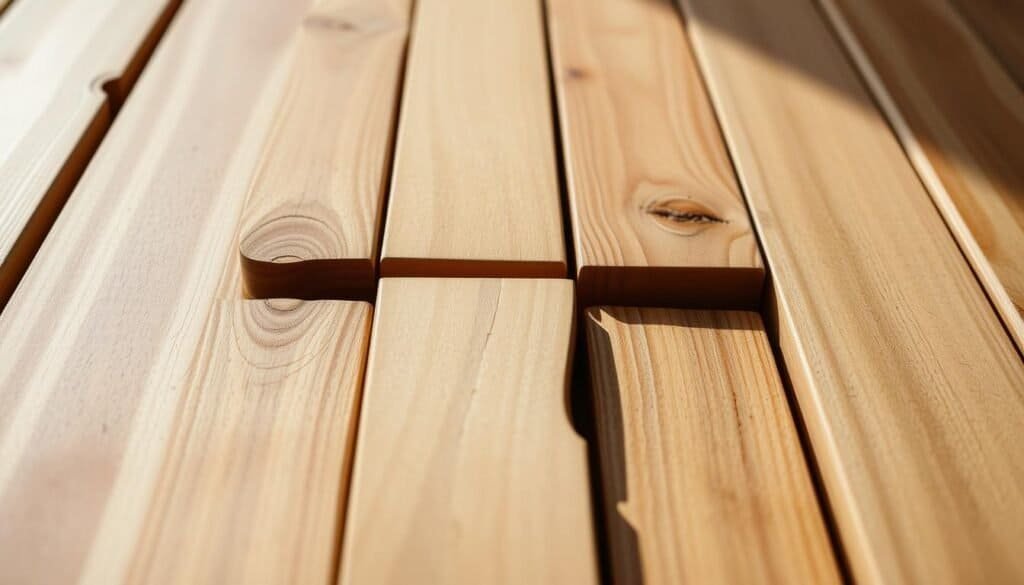
Now, tongue and groove joints are used in wall features, adding texture and interest. This change brings a natural feel to homes. It fits well with many decor styles.
Router Bits and Setup for Perfect T&G Joints
Creating perfect tongue and groove joints needs the right router bits and setup. Special router bits cut the tongue and groove for a tight fit. It’s important to calibrate the router for accurate cuts.
If you want to use tongue and groove joints, get quality router bits. Also, spend time setting up your router. This will make your joints look good and work well, improving your woodwork’s look.
Butterfly Keys (Bow Ties): Structural Repair as Decorative Element
Butterfly keys in furniture making turn repairs into something beautiful. These keys, also called bow ties, are not just useful. They also make the furniture look good. They help keep joints strong and stop cracks from getting worse.
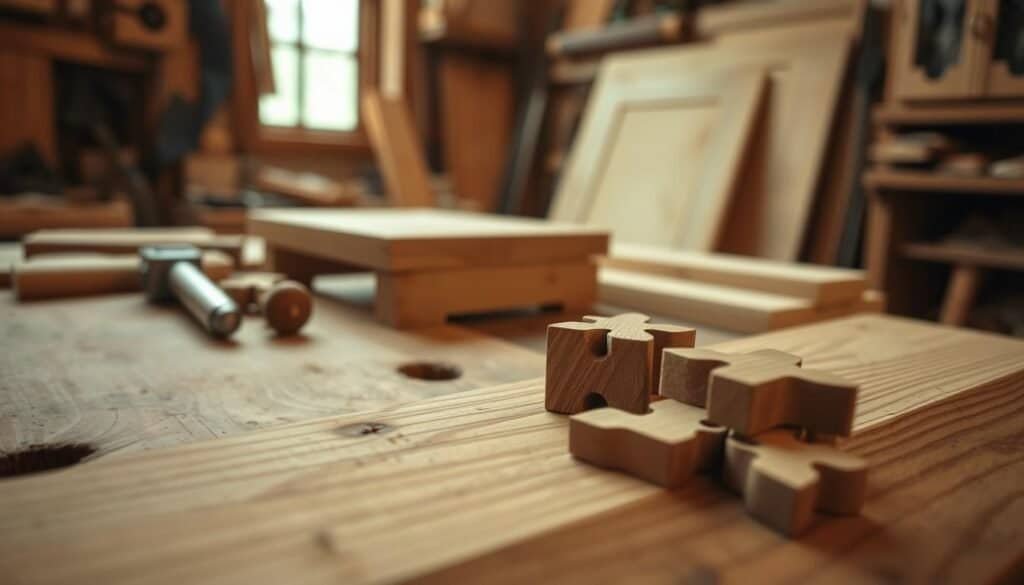
At first, butterfly keys fixed cracks in wood. But now, they’re used to make furniture look cool. The contrast between the key and the wood can be really eye-catching.
Templates and Techniques for Consistent Butterfly Keys
Woodworkers use templates to make sure butterfly keys look the same. These templates help cut the keys to the right size and shape. Different methods are used to make sure the keys fit perfectly, making the piece look and feel better.
Learning to use butterfly keys well lets woodworkers add a special touch to their work. They mix old repair methods with new design ideas. This creates a piece that lasts long and shows off the craftsman’s skill and care.
Knockdown Fittings: Modern Joinery for Adaptable Living Spaces
Knockdown fittings have changed how we design furniture. They make furniture that can change with your needs. This is great for homes that are always evolving.
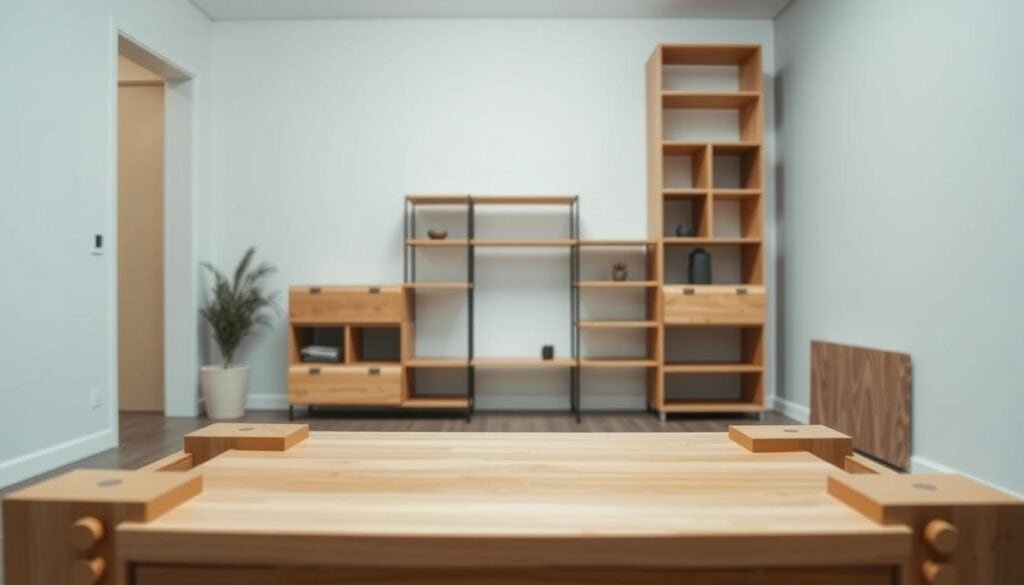
Knockdown fittings let furniture be easily taken apart and put back together. This is perfect for people who move a lot or need their space to change. The furniture looks great and is built to last, making it perfect for today’s homes.
High-End Hardware Options for Quality Furniture
Choosing the right knockdown fittings is key for top-notch furniture. Brands like Hettich and Blum offer stylish and strong fittings. These fittings make sure your furniture stays strong, even after being taken apart and put back together many times.
Using knockdown fittings in furniture design is a big step towards better living spaces. As people want furniture that can change, these fittings will play an even bigger role.
Conclusion: Integrating Traditional Joinery into Your Contemporary Home
Traditional joinery techniques add elegance to your modern home. They range from dovetail joints to lap joints, each with its own charm. These styles make furniture truly special.
Using traditional joinery in your home decor brings heritage and quality. It’s perfect for both experts and hobbyists. It makes your projects stand out and adds sophistication to your space.
When adding joinery to your home, think about the look and function you want. Knowing different joinery styles helps you mix old and new. This way, you create a welcoming and stylish home.

